Spot-tailed Quoll
Spot-tailed QuollDasyurus maculatus maculatus | |
|---|---|
| Kingdom: | Animalia |
| Phylum: | Chordata |
| Class: | Mammalia |
| Subclass: | Marsupiala |
| Order: | Dasyuromorphia |
| Status | |
| Australia: | Endangered (EPBC Act) |
| Victoria: | Endangered (FFG Threatened list 2025) |
| FFG: | Action Statement No. 15 |
| Profiles | |
| Australia: | Atlas of Living Australia |
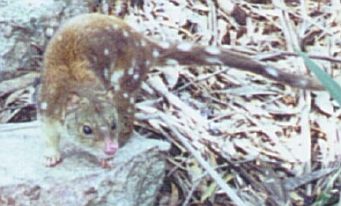
Also known as the Tiger Quoll or Native Cat, the Spot-tailed Quoll is the largest marsupial carnivore on mainland Australia and occurs in Victoria, New South Wales, Queensland and Tasmania. Slightly larger than a domestic cat, the Spot-tailed Quoll is coloured light to dark golden brown to almost black with conspicuous white spots on its body and tail. Males are larger than females and have a head-body length between 380-760mm with a tail length of 370-555mm.
Close relatives of the Spot-tailed Quoll;
- Eastern Quoll Dasyurus viverrinus considered regionally extinct in Victoria and across mainland Australia.
- Western Quoll Dasyurus geoffroii considered regionally extinct in Victoria.
- Northern Quoll Dasyurus hallucatus only occurs in northern Australia.
There are two recognised Subspecies of the Spot-tailed quoll;
- Dasyurus muculatus gracilis (northern Queensland)
- Dasyurus maculatus maculatus (southeast Queensland, New South Wales, Tasmania and Victoria).
Tasmanian and mainland Spot-tailed Quolls have been found to form two distinct evolutionary units which may justify a separate sub-species (Edgar 1983, Watt 1993, Firestone et al. 1999, DSE 2003).
Genetic studies have found there is little evidence that quolls from south-west Victoria are genetically distinct from quolls in eastern or central Victoria or from New South Wales populations. The results suggest that mainland populations of Dasyurus maculatus maculatus form one evolutionary significant unit and the Victorian populations form one management unit and that Quolls in North East Victoria have the highest genetic diversity (Belcher 2006).
Distribution
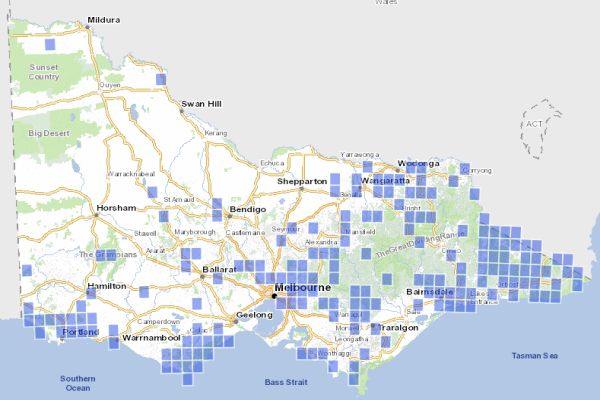
All known historic records indicating the distribution of Spot-tailed Quoll in Victoria. Source: VBA 2025
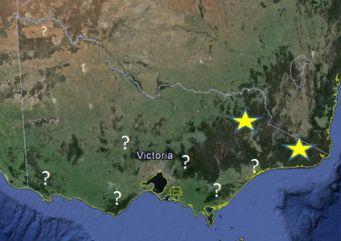
Many populations of Spot-tailed Quoll have experienced a significant decline over the past 20-30 years to the extent where there is a question over their long term viability. North East Victoria and East Gippsland are considered stronghold areas for this species.
In 1984 it was estimated that the Spot-tailed Quoll had suffered a 50% reduction in its known range since European settlement (Mansergh 1984). Since that date there has been a further decline in population and range with reduced sightings and low survey counts. The main stronghold areas for this species in Victoria are now in North East and East Gippsland.
In south-west Victoria there is grave concern for ongoing survival at Mt Eccles and the Otways. For example in 1999 there were only 3 records from 51 survey sites in the Otways (Belcher 2000). It is now considered that populations of Dasyurus maculatus in Southwest Victoria, including the Otway Ranges, Cobobbonee State Forest, Mt Eccles National Park and the Mt Eccles lava flow are critically endangered (Belcher 2006).
Between 2020 and 2025 all records have been confined to eastern Victoria. Most records are in the Alpine National Park (33), Snowy River National Park (21) and the upper Snowy (11). There have been no record sightings in South Gippsland, Otway Ranges and far western Victoria. (Data derived from Victorian Biodiversity Atlas 2025).
Habitat and ecology
.jpg) |
| Spot-tailed Quoll, image taken with remote camera in Great Otway National Park, April 2014. Source: Parks Victoria - Otways |
The Spot-tailed Quoll occupies a range of forest habitats, particularly wet eucalypt forests associated with rocky outcrops, extensive riparian vegetation and high levels of ground dwelling prey. They have a large home range in excess of 580ha but could be up to 2200 hectares, which is influenced by the quality of habitat and availability of den sites. Males can use one or more den sites, which can be made in hollow logs, hollow trees, rock crevices and caves. During a single night an individual may range over several kilometres. Movement of males is greater than females, particularly during the breeding season, which extends from April to July. Females may carry up to 6 young, which become independent after 18 weeks.
Spot-tailed Quolls are mainly nocturnal feeders but have been observed in daylight hours. They are proficient climbers and opportunistic feeders, feeding on terrestrial and arboreal prey such as small mammals (eg. antechinus, bush rat), medium sized mammals (possums, gliders, and rabbits), birds and insects. Larger mammals such as wallabies have been analysed in scats indicating a scavenging and opportunistic feeding behaviour. Areas known as latrine sites serve as communal defecation sites and are often situated in exposed areas such as rock ledges. It is believed these areas may serve a role in communication of territory and possibly reproductive status (Edgar 1983, Watt 1993, Mansergh 1995, DSE 2005).
Threats
Competition; foxes and cats preying on potential quoll prey is a problem where forest habitats have extensive boundaries with rural landscapes, opening up areas of forest through construction of vehicular and foot tracks also exacerbates the problem by providing easy access to competitor species.
Fragmentation of populations; this has occurred in areas of western Victoria such as the Otway Ranges, Mt Eccles, parts of the central highlands and forests in the far south-west. Fragmentation of populations could result in inbreeding or insufficient numbers to sustain viable populations.
Illegal killing; trapping, shooting and poisoning by landowners, largely due to their predation on domestic poultry.
Too frequent burning; this can result in a loss of structurally complex habitats which are needed for foraging and denning opportunities.
Predation; foxes, feral cats and dogs pose a direct threat to quolls.
Road kills; this problem is identified where busy roads pass through habitat or habitat linkages.
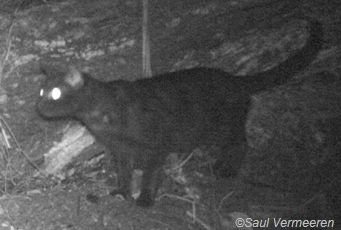 | 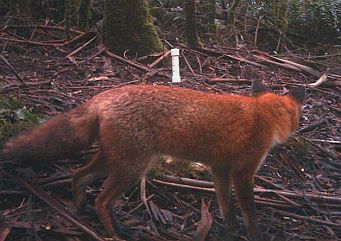 |
| Feral Cats and Foxes were frequently photographed by remote cameras in the Otway Ranges during surveys in 2012. Images: Saul Vermeeren | |
The issue of non-target poising
For some time there were concerns that 1080 baiting programs carried out to control populations of wild dogs and foxes were having a detrimental impact on Spotted-tailed Quoll populations (Belcher 1998). Recent studies (Koertner and Watson 2005, Claridge and Mills 2007, Koertner 2007) have emphatically demonstrated that 1080 baiting programs are unlikely to have any demonstrable impact on populations of quolls. In some populations the baiting programs may even have been beneficial, reducing the populations of canids at the time when juvenile quolls are leaving the natal den and prone to predation.
The remaining concern regards the indiscriminate use of baits in private land areas adjacent to forest habitats where local quoll population sizes are small or isolated and impacts from secondary poisoning particularly where feeding on poisoned rabbits could occur. (Belcher 1998, Belcher 2000).
The recovery of Spotted-tailed Quolls (and the eventual re-introduction of Eastern Quolls) in Victoria will require an effective landscape-scale fox control program in order to ensure success."
Fox control as conducted through programs as the Southern Ark and Glenelg Ark in Victoria is a highly targeted process that quolls will need if they are ever to recover.
Management actions for conservation of the Spot-tailed Quoll in Victoria
In 2016 the National Recovery Plan was released. This document paves the way for the formation of a National Recovery Team with scientists and land managers from New South Wales, Victoria, the ACT, Queensland and Tasmania collaborating in an effort to undertake conservation measures across this species range.
In Victoria, there have been a number of significant management actions within the last 20 years aimed at securing the viability of Spot-tailed Quoll populations. In areas where timber is harvested Forest Management Plans now have stipulated management actions specific to Spot-tailed Quoll such as creation of special protection zones (SPZ) where quolls are known to exist, in addition protection of den sites and habitat corridors are included in timber harvesting plans.
Predator control activities now take account of the need to ensure quolls are not inadvertently killed through baiting programs. The use of remote cameras has improved the efficiency of survey techniques and standards have been established for the use of this technology (DEPI 2010). Large predator programs such as Southern Ark and Glenelg Ark provide a long term effort at control predators.
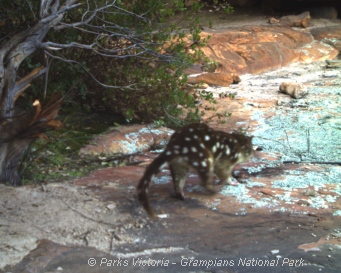 |
| Spot-tailed Quoll image taken with remote camera in Grampians National Park, August 2014. Source: Parks Victoria - Grampians. |
In many parts of Victoria quoll habitat has been protected within new National and State parks, e.g. the Angahook – Otway Investigation (VEAC 2004) has resulted in an increase in sites where known records have been incorporated into permanent reserves in the Otways from 15% to 59% of sites now in permanent reserves. Creation of the Cobboboonee National Park in 2009 has provided long term protection of Spot-tailed Quoll habitat in this area.
Despite quoll habitat being protected in National and State Parks there is an ongoing decline in this species across much of its range in Victoria. The question is why is this happening? Are quolls adequately protected from predators and competition from the Red Fox and Feral Cats and are there enough quolls remaining in our parks and reserves to sustain a viable long term population?
It has been found that the population with the highest genetic diversity (North East Victoria) would be the most suitable source for obtaining quoll’s for translocation (Belcher 2006).
Key areas for the Spot-tailed Quoll in Victoria are in East Gippsland and North East Victoria. Since 2004 there have been only 26 confirmed records in Victoria (VBA 2014) with the vast majority of records occurring in the North East and East Gippsland. There have been sporadic reports from some other areas within the quoll's Victorian distribution but apart from East Gippsland and the North East the long term conservation status of this species across much of its former range in Victoria is of concern due to low numbers.
Conservation measures in East Gippsland and Gippsland
Areas in East Gippsland contain ideal quoll habitat and are regarded as a stronghold for this species in Victoria. In 2011/12 remote camera surveys were carried out across 60 sites in areas where fox control was carried out as part of the Southern Ark program.
Monitoring the abundance of Spot-tailed Quolls and predators is undertaken inside and outside predator control programs areas to determine the impacts and effectiveness of predator control efforts.
Broad-scale monitoring is carried out to determine the distribution and status of Spot-tailed Quolls in State Forest and Spot-tailed Quoll protection zones (SPZ's). Monitoring the impact of logging and efficacy of current conservation prescriptions to maintain habitat will assist in applying forest management prescriptions for habitat protection where quolls are found.
VicForests’ Targeted Species Surveys
VicForests undertakes Pre-Harvest Biodiversity Surveys in all areas planned for harvest. The VicForests Pre-Harvest Surveys – Targeted Species Survey Procedure 2016 (pdf) includes information about survey methodologies to be used for target species, the minimum standards for field surveys, and requirements for recording of information and reporting of results. Specifically surveys for Spot-tailed Quoll;
Preferred survey method
- Remote camera survey, 2 cameras per 100 ha over a period of minimum 21 days.
- Walking Transect Survey - 200m per 10ha
Density threshold triggering prescriptive action - Verified sighting of a quoll from remote camera. Presence of latrine or den sites found in walking survey.
Wild dog and fox baiting
DEECA is responsible for ensuring adequate training for personnel involved with wild dog and fox baiting programs to minimise the risks to Quolls.
Snowy River National Park - the park contains high quality habitat for Spot-tailed Quolls which still supports a relatively large population.
Remote camera surveys were conducted over three years between 2010 - 2013 in areas that were planned for introduced predator control through the Gelantipy Community Baiting Program. There is on-going monitoring to assess effectiveness of predator control programs. The DELWP co-ordinates fox control as part of Southern Ark and Brush-tailed Rock-wallaby programs.
Errinundra Plateau - quolls detected during 2011/12 surveys.
Mount Stradbroke - In 2011 trials to refine remote camera survey protocols were undertaken in the Upper Snowy River population. This project was part of research into "The Distribution and Status of the Spot-tailed Quoll in the Alpine and Snowy River National Parks. DEPI (Nelson, Belcher & Scroggie 2010).
Moondarra State Park - Parks Victoria was scheduled to conduct a survey in 2012/13 to determine the status and extent of the population. There is also recognition of the need to protect potential quoll habitat from fire management activities where possible.
Rawson - establish Special Management Zone and Special Protection Zone around Rawson and Erica forest timber harvesting areas to conserve Quoll habitat.
Central Gippsland including Strzelecki Ranges - remote camera surveys undertaken in 2004/05 and 2011/12 to confirm presence of populations. Surveys in the Strzelecki Ranges were planned for 2013.
Conservation measures in North East Victoria
Alpine National Park (North East Victoria and Gippsland) - The Alpine National Park is a key area for Spot-tailed Quolls and one of the few areas of Victoria where the species can be readily detected during surveys.
Monitoring is conducted to collect data which will assist in understanding survival, reproduction and dispersal of quolls. Every three years broad-scale population monitoring is undertaken to determine population trends. Survey and monitoring protocols have been developed which allow quolls, foxes and cats to be monitored simultaneously using remote cameras.
Control of predators such as wild dogs and foxes is undertaken in this area.
In April 2021, the Australian Quoll Conservancy commenced investigating the spotted-tailed Quoll population status in the Alpine National Park.
Burrowa Pine Mountain National Park - surveys are required to find latrine sites.
Chiltern-Mt Pilot National Park - Wooragee Landcare Group is involved with hair tube surveys and surveying to find latrines sites in the rocky outcrop complexes. There are signs that quolls are resent but probably in low numbers. Parks Victoria will undertake surveys to confirm existing records. Parks Victoria undertakes fox baiting at 76 bait stations covering 7300 ha.
Mount Lawson State Park - Parks Victoria in association with the Wooragee Landcare Group surveyed for Quolls in 2005 with no quolls found. Further surveys are required.
Mount Samaria State Park - a probable hair tube record was recorded in 2002. Additional surveys required. Fox control in this area forms part of the Southern Ark fox control program.
Mount Stanley Scenic Reserve - a survey to confirm known records and to find latrine sites is required.
Strathbogie State Forest - remote cameras were used to survey 40 sq.km in 2009/10. This follows on from large scale hair tube surveys in 2005/2006 and surveys in 2006/07 which both yielded poor results. Further remote camera surveys are scheduled.
Warby Range State Park - a search for latrine sites is to be carried out but no dates set.
Upper Goulburn Kinglake National Park, Big River, Dixons Creek, Gaffneys Creek - remote camera surveys as required to confirm existing records.
Conservation measures in South West Victoria
Cobboboonee National Park
- Hair tube monitoring for STQ is conducted as part of Glenelg Ark project.
- Fox baiting protocols developed to ensure fox baiting in Glenelg Ark project does not threaten Spot-tailed Quolls through intensive sand pad monitoring to determine cause of bait takes, and ensuring poisoned baits are buried at least 15 cm.
Mt Eccles National Park
- Ensure all pest animal control activities in areas of known Quoll populations comply with current best practice prescriptions to minimise the risks of baiting programs to Quolls. This will include holding information sessions and training days for DELWP staff and others involved in wild dog and fox control.
- Where practical, include community involvement with Quoll conservation efforts, such as in surveys using hair tubes, and community fox control efforts on private land near Quoll populations and/or with Quoll habitat.
- Undertake hair-tube survey and scat surveillance 2011/2012.
Tyrendarra Lava Flow - Mostly Private and also incorporates Windamara Indigenous Protected Area
- Coordinate camera surveys and scat searches 2010/2011.
Great Otway National Park and Otway Forest Park
- Poor results from planned survey efforts with only 2 random records between 2008 and 2014, a scat at Lorne was confirmed and a hair tube returned positive overall a very low detection rate through the Otway Ranges. A remote camera image was taken in April, 2014.
- Parks Victoria to liaise with DEECA to ensure that fox management and fire suppression activities are conducted in a manner to reduce any potential impact on spot-tailed quoll populations or habitat.
- DELWP to provide input into fire management plans to minimise the impact of fire suppression on spot-tailed quoll habitat.
- Parks Victoria conducts surveys to determine the status and extent of population in Otway National Park.
- Support and fund community groups to undertake Quoll survey work in the Otway Ranges Bioregion.
Grampians National Park
- Monitor in conjunction with other fauna programs.
Other State Wide management actions for Spot-tailed Quoll conservation
- Develop a model that will assist in determining the probability of detection of a Quoll within an animal's home range, and developing a sampling and analytical framework to assess Quoll habitat (Completed).
- Ensure the provision of regular information updates on Quoll conservation to land/resource managers – (ongoing).
- Determine the impact of broad-scale fox control initiatives on Quoll populations at experimental sites – (completed).
- Review current survey methods and conduct additional research as required, to assess the relative effectiveness of different techniques, or combination of techniques, to identify optimal survey protocol – (completed).
- Negotiate with land management agencies to incorporate the protection of rocky outcrop and riparian zones into fire management prescriptions within areas of known spot-tailed quoll habitat (on-going).
- Continue to collect biological and ecological data on Spot-tailed Quoll as opportunities arise, to help compile information on the species for more effective conservation management
- Monitor the abundance (or an index of abundance) of spotted-tailed quolls and introduced predators in areas with and without predator control programs.
Bushfire Recovery Community Wildlife Reporting
This project is calling on members across the community to report sightings of six key species (inc. Spot-tailed Quoll) within 2019-2020 fire-affected and neighbouring) areas. Bushfire Recovery Community Wildlife Reporting
Tiger Quoll Research Program - Conservation Ecology Centre - Cape Otway
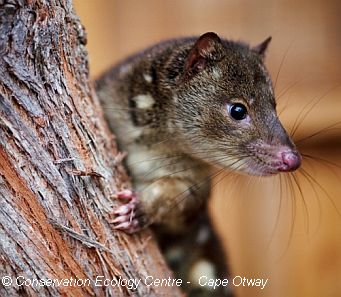 |
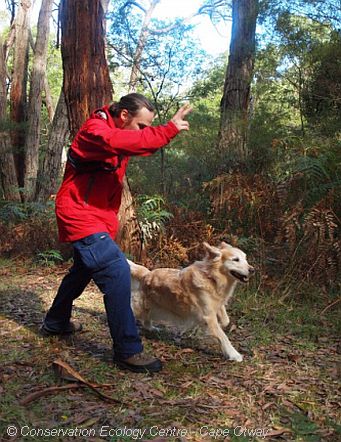 |
| The CEC’s scat detection dogs in training. |
Tiger Quolls are the largest extant marsupial predator on mainland Australia and considered to be in decline across their range. The Otways, once a stronghold for the species, was devoid of any confirmed Tiger Quoll observation for about a decade until the CEC’s Tiger Quoll Research Program unearthed two Tiger Quoll scats in 2012. Through analysis of extracted DNA, these samples were confirmed as Tiger Quoll positive. The CEC continues to pursue further evidence of the species and is concentrating its efforts on trialling novel detection techniques including the use of scat detection dogs. Once techniques prove to be reliable and effective, management decisions can be made with greater confidence and with the potential to preserve this iconic species.
Otway Conservation Dogs
The CEC’s scat detection dogs, The Otway Conservation Dogs, are a team of dog handlers and their dogs being trained by the CEC in conjunction with Canidae Development to search for Tiger Quoll scat. The dogs are trained to detect quoll scat and indicate a find through passive behavioural responses so as not to disturb native wildlife. Conservation Dogs have the potential to increase the number of Tiger Quoll detections drastically. We anticipate the first deployment of the Otway Conservation Dogs will be in 2014.
Australian Quoll Conservancy Inc. (AQC)
The AQC has projects which investigate the distribution and population of the Spotted-tailed Quoll Dasyurus maculatus maculatus in Victoria.
Surveys 2018 - 2020
The Australian Quoll Conservancy Inc (AQC) Victorian “Species Recovery Unit” has now taken shape with several professionals, business owners and passionate quoll individuals from Victoria.
The AQC has an DELWP approved 3 year project launched on June 16, 2018 in Melbourne. The project timeline has a strong possibility to extend thereafter as AQC survey aims to significantly contribute to the growing body of knowledge of wild Spotted-tailed quoll plausible populations at the Northern & Eastern Victoria Bioregions locations.
The current species confined home range along with their cryptic and nocturnal habits makes detection of quoll populations problematic, especially as the species now occur at low densities. Victorian members of the public are encouraged to report sightings directly to the Australian Quoll Conservancy.
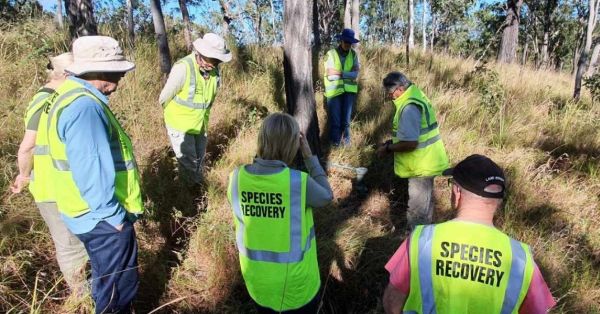
Australian Quoll Conservancy Inc. Citizen Science volunteers at survey area in Victoria. Source: AQC.
To improve the ability of this survey, the AQC is using motion cameras with non invasive gender quoll detection methodology, these have been extremely successful in North Queensland identifying species gender as well as their current breeding status speeding up the process of determining established quoll colonies and/or roaming males in search of mates.
Scheduled areas: Currently AQC Species Recovery teams are surveying Toolangi, Kinglake, Lerderderg, Wombat and Erica areas and expanding from these areas as coverage intensifies.
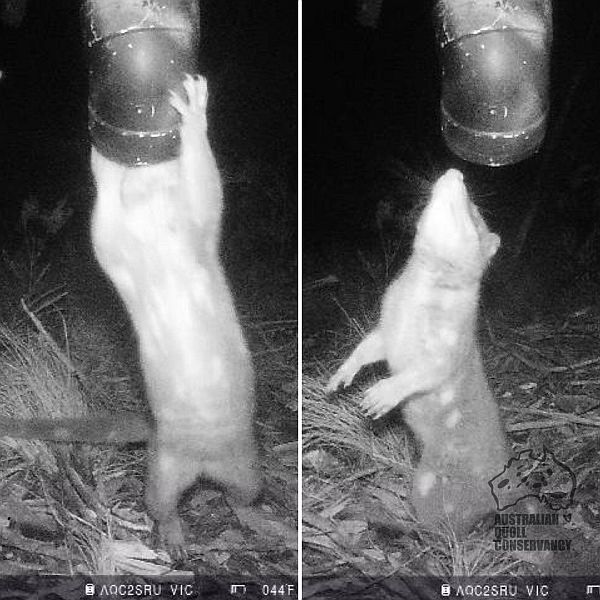
Spot-tailed Quoll investigating the quoll attracting bait at one of the remote camera stations. Source: AQC.
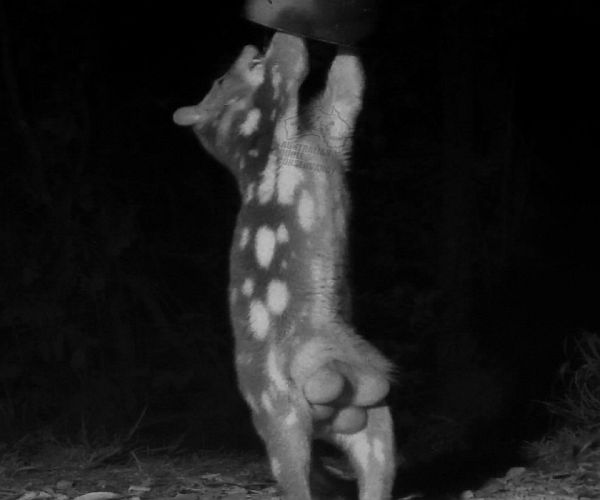
Female Spot-tailed Quoll with pouched young at remote camera station. Source: AQC.
Contact: Alberto Vale / President / Australian Quoll Conservancy aqc@quolls.org.au or mobile: 0412 632 328
Surveys in the Alpine National Park and Snowy Mountains National Park
Commencing April 2021 - ongoing subject to funding.
The project is a long-term population study developed with species-specific monitoring protocols with proven non-invasive and best animal welfare methods. These applied methodologies facilitate individual identification, sexing, and pouch young status, including automated weighing with no need for cage traps or the physical handling of animals.
This project helps build and maintain a robust citizen science program and form constructive partnerships.
Contact: aqc@quolls.org.au
References
- Belcher, C. (1998) Susceptibility of the tiger quoll, Dasyurus maculatus, and the eastern quoll, D. viverrinus, to 1080-poisioned baits in control programmes for vertebrate pests in eastern Australia, Wildlife research, v. 25 no. 1, 1998, p. 33-40.
- Belcher, C. (2000) The Range, Status and Distribution of the Spot-tailed Quoll (Dasyurus maculatus) in the Otway Ranges, unpublished report to Dept. Natural Resources & Environment for West Victoria Regional Forest Agreement, February 2000.
- Belcher, C. (2006) Genetic Status of the Spotted-tailed Quoll, Dasyurus maculatus, in south-west Victoria, report to Glenelg Hopkins Catchment Management Authority.
- Claridge, A.W., and
Mills , D.J. (2007)Aerial baiting for wild dogs has no observable impact on spotted-tailed quolls (Dasyurus maculatus) in a rainshadow woodland . Wildlife Research 34, 116–124. - DCE (1991) Forests Management Plan Otway Area, vol 1. Statement of Resources & Values, vol 2.FMA Management Plan, Department of Conservation & Environment, Victoria.
- DEPI (2010) Spot-tail Quoll Survey Standards, 2 May 2011, Nelson, Belcher & Scroggie 2010,, Department of Environment and Primary Industries, Victoria (pdf).
- DSE (2023) Flora and Fauna Guarantee Spot-tailed Quoll Action Statement, (now Department of Energy, Environment and Climate Action, Victoria). DEECA, Flora and Fauna Guarantee Action Statement No. 15 pdf
- Edgar, R. (1983) Spotted-tailed Quoll Dasyurus maculatus; in The Australian Museum Completed Book of Australian Mammals, pp18, (Ed) Strahan, R., Angus & Robertson.
-
Flora and Fauna Guarantee Act 1988 - Threatened List - March 2025 Department of Energy, Environment and Climate Action (DEECA), Victoria.
- Firestone, K. B., Elphinstone, M. S., Sherwin, W. B. & Houlden, B. A. (1999)Phylogeographical population structure of tiger quolls Dasyurus maculatus (Dasyuridae: Marsupialia), an endangered carnivorous marsupial. Molecular Ecology 8 (10), 1613-1625.doi: 10.1046/j.1365-294x.1999.00745.x
- Körtner ,G.,
Peter Watson, P. (2005) The immediate impact of 1080 aerial baiting to control wild dogs on a spotted-tailed quoll population. Wildlife Research 32(8) 673–680 - Körtner, G. (2007)
1080 aerial baiting for the control of wild dogs and its impact on spotted-tailed quoll (Dasyurus maculatus) populations in eastern Australia . Wildlife Research 34, 48–53. - Mansergh, I.M. (1984)The status distribution and abundance of Dasyurus maculatus (Tiger Quoll in Australia with particular reference to Victoria. Aust Zool. 21(2):109-122.
- Mansergh, I.M. (1995) Spot-tailed Quoll (Dasyurus maculatus), in Mammals of Victoria (Ed) Menkhorst, P., pp 51-52, Oxford University Press, Melbourne.
- RFA (2000) West Victoria Regional Forest Agreement between the Commonwealth of Australia and the State of Victoria, March 2000.
- VBA (2017) Victorian Biodiversity Atlas, Department of Environment, Land, Water & Planning, Victoria.
- VEAC (2004) Angahook-Otway Investigation Final Report, Victorian Environmental Assessment Council, November, 2004.
- VicForests (2016) VicForests Pre-Harvest Surveys – Targeted Species Survey Procedure 2016 (pdf).
- Watt, A. (1993), Conservation Status and Draft Management Plan for Dasyurus maculatus and D. hallucatus in Southern Queensland, Final Report to the Queensland Department of Environment & Heritage and the Department of Environment, Sport and Territories, Oct 1993.
Partnerships
- Friends of Eastern Otways carry out regular hair-tubing surveys within the Great Otway National Park in co-operation with Parks Victoria.
- Parks Victoria are engaged in remote camera surveys as part of the Signs of Healthy Parks program Ph (03)5263 1085
See also:
- Spot-tailed Quoll, Species profile and threats database - Department of Environment
- National Recovery Plan 2016 pdf
- Conservation Ecology Centre - Cape Otway
- IUCN Red List - Dasyurus maculatus
Other pages on the use of remote cameras
- Signs of Healthy Parks program
- Pilot remote camera survey in the Grampians 2010

